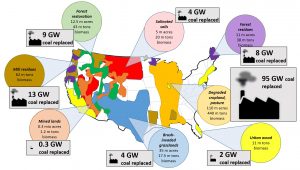Opinion Low-risk Bioenergy Can Be A Critical Climate Solution
A group of experts from the bioenergy space are pushing for its use to comply with the newly final Clean Power Plan claiming low-risk versions of the energy source offer a host of benefits ranging from reducing greenhouse gas emissions to restoring degraded lands.

10 August 2015 | In the Obama Administration’s Clean Power Plan issued last week, EPA recognized that states may use bioenergy to reduce emissions from fossil fuel power plants. The plan, however, indicates strict sustainability and accounting rules will be required. The New York Times and Washington Post in recent months have both showcased concerns with bioenergy and its ability to reliably reduce emissions. However, we believe there are plentiful biomass resources available that would meet strict environmental and emissions accounting criteria, which we call “low-risk.” These resources can play an important role under the Clean Power Plan (CPP), if states put in place the right policies to ensure low-risk biomass is utilized.
Examples of low-risk bioenergy include biomass waste that otherwise ends up in a landfill and decays, forest residues that would otherwise be burned in piles in the field, and byproducts such as sawdust and wood chips from timber processing. All of these “waste and residue” materials are likely to result in instant greenhouse gases emissions. Using them for energy and offsetting fossil fuels is the smart and low-risk choice. EPA has already indicated these resources are very likely to be approved under state plans for CPP compliance.
There is also significant potential for proactively beneficial “conservation biomass” – biomass that can help restore degraded landscapes. Examples include invasive species, diseased trees, and sustainably-harvested native grasses grown on mined, salinated, and otherwise degraded land. For example, invasive brush in Texas has overtaken the historical tall-grass prairie, degrading soil quality, reducing grassland species habitat, and decreasing the value of the land for rural communities. Hundreds of thousands of acres in Texas are treated for brush removal every year. Much of this material is burned in piles in the field. Using this woody material as renewable energy should be encouraged.
Other sources of conservation biomass include growing native grasses on underutilized pasture land, mined land, and other landscapes no longer suitable for growing food or other uses. Another option is using diseased or pest-infested trees in areas where their removal improves forest health and reduces wildfire risk. In all, over 600 million dry tons could be available annually from conservation biomass and other low-risk categories – enough to offset over 60 percent of current U.S. coal power. Mobilizing this biomass would require a sea change in bioenergy markets and depends heavily on sourcing costs. But this gives a sense of how important sustainable bioenergy can be over the longer term in reducing greenhouse gas emissions. While low-risk categories may not always be the cheapest biomass option, the right sustainability policies can ensure it is competitive in the marketplace.
EPA will require that states monitor and track the origin of biomass resources and demonstrate their carbon neutrality. There are many ways to do this in ways that have been demonstrated in other parts of the world, like the UK and Netherlands. As researchers, landowners, industry, policymakers, and other stakeholders, we should have a constructive debate around how to ensure U.S. bioenergy meets sustainability, carbon accounting, and monitoring criteria. We can make sure bioenergy delivers real climate benefits, as well as improved landscapes and healthy, growing forests.
- USDA NRCS 2010: Native Invasive Woody Species. 14p
- Lal, Rattan 2003: Testimony concerning soil carbon sequestration by agricultural and forestry land uses to mitigate climate change.
- USFS 2014 U.S. Forest Resource Facts and Historical Trends. USFS Gen. Tech. Rep. 1035, 64p.
- NREL 2014. The Biofuels Atlas. National Renewable Energy Laboratory.
- USFS 2012. Increasing the Pace of Restoration and Job Creation on Our National Forests. USFS, 20p.
- USFS 2005. A Strategic Assessment of Forest Biomass and Fuel Reduction Treatments in Western States. USFS Gen. Tech. Rep. RMRS-GTR-149, 20p.
- US DOI BLM 2014: Abandoned Mine Lands Inventory; US EPA 2015: RE-Powering America’s Land Initiative, Renewable energy on potentially contaminated land, landfills and mine sites, 3p.
- USDA NRCS 2001: Interim Appraisal and Analysis of Conservation Alternatives, 122p.
Low-risk and conservation biomass potential in the US.
Please see our Reprint Guidelines for details on republishing our articles.




Excellent writing . I loved the facts . Does anyone know where I could get ahold of a template IRS 1023 document to work with ?